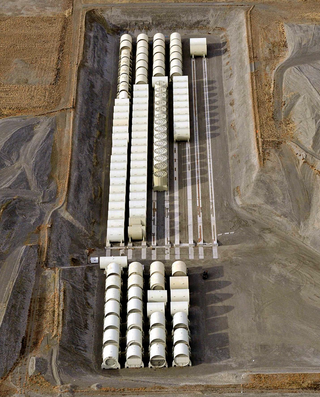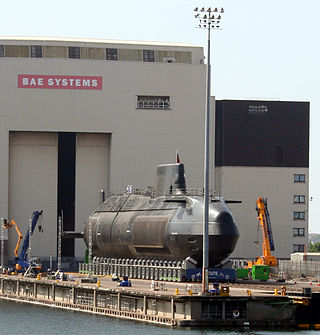
United States naval reactors are nuclear reactors used by the United States Navy aboard certain ships to generate the steam used to produce power for propulsion, electric power, catapulting airplanes in aircraft carriers, and a few more minor uses. Such naval nuclear reactors have a complete power plant associated with them. All commissioned U.S. Navy submarines and supercarriers built since 1975 are nuclear powered, with the last conventional carrier, USS Kitty Hawk, being decommissioned in May 2009. The U.S. Navy also had nine nuclear-powered cruisers with such reactors, but they have since been decommissioned as well.
The S1G reactor is a naval reactor used by the United States Navy to provide electricity generation and propulsion on warships. The S1G designation stands for:
The D1G reactor was a prototype naval reactor designed for the United States Navy to provide electricity generation and propulsion on warships. The D1G designation stands for:

USS Seawolf (SSN-575) was the third ship of the United States Navy to be named for the seawolf, the second nuclear submarine, and the only US submarine built with a liquid metal cooled (sodium), beryllium-moderated nuclear reactor, the S2G. Her overall design was a variant of Nautilus, but with numerous detail changes, such as a conning tower, stepped sail, and the BQR-4 passive sonar mounted in the top portion of the bow instead of further below. This sonar arrangement resulted in an unusual bow shape above the water for a U.S. submarine. Originally laid down in 1953, her distinctive reactor was later replaced with a standard pressurized water reactor, the replacement process lasting from 12 December 1958 to 30 September 1960.
The S1C reactor was a prototype naval reactor designed for the United States Navy to provide electricity generation and propulsion on warships. The S1C designation stands for:

USS Nautilus (SSN-571) was the world's first operational nuclear-powered submarine and the first submarine to complete a submerged transit of the North Pole on 3 August 1958. Her initial commanding officer was Eugene "Dennis" Wilkinson, a widely respected naval officer who set the stage for many of the protocols of today's Nuclear Navy of the US, and who had a storied career during military service and afterwards.

The Skate-class submarines were the United States Navy's first production run of nuclear-powered submarines. They were an evolution of the Tang class in everything except their propulsion plants, which were based on the operational prototype USS Nautilus. The four Skate class boats re-introduced stern torpedo tubes. Although among the smallest nuclear-powered attack submarines ever built, the Skate class served for many years, with the last being decommissioned in 1989. USS Skate was the first submarine to surface at the North Pole, on 17 March 1959.
The S6G reactor is a naval reactor used by the United States Navy to provide electricity generation and propulsion on Los Angeles-class attack submarines. The S6G designation stands for:

A nuclear submarine is a submarine powered by a nuclear reactor, but not necessarily nuclear-armed. Nuclear submarines have considerable performance advantages over "conventional" submarines. Nuclear propulsion, being completely independent of air, frees the submarine from the need to surface frequently, as is necessary for conventional submarines. The large amount of power generated by a nuclear reactor allows nuclear submarines to operate at high speed for long periods, and the long interval between refuelings grants a range virtually unlimited, making the only limits on voyage times being imposed by such factors as the need to restock food or other consumables.
The A1W reactor is a prototype nuclear reactor used by the United States Navy to provide electricity generation and propulsion on warships. The A1W designation stands for:
The S1W reactor was the first prototype naval reactor used by the United States Navy to prove that the technology could be used for electricity generation and propulsion on submarines.

Nuclear marine propulsion is propulsion of a ship or submarine with heat provided by a nuclear reactor. The power plant heats water to produce steam for a turbine used to turn the ship's propeller through a gearbox or through an electric generator and motor. Nuclear propulsion is used primarily within naval warships such as nuclear submarines and supercarriers. A small number of experimental civil nuclear ships have been built.
Air-independent propulsion (AIP), or air-independent power, is any marine propulsion technology that allows a non-nuclear submarine to operate without access to atmospheric oxygen. AIP can augment or replace the diesel-electric propulsion system of non-nuclear vessels.

Machinist's mate is a rating in the United States Navy's engineering community.

The S2G reactor was a naval reactor used by the United States Navy to provide electricity generation and propulsion on warships, and the only liquid metal cooled reactor yet deployed by the US Navy. The S2G designation stands for:

The S3W reactor is a naval reactor used by the United States Navy to provide electricity generation and propulsion on warships. The S3W designation stands for:

The S6W reactor is a naval reactor used by the United States Navy to provide electricity generation and propulsion on warships. The S6W designation stands for:
The United States Navy Nuclear Propulsion community consists of Naval Officers and Enlisted members who are specially trained to run and maintain the nuclear reactors that power the submarines and aircraft carriers of the United States Navy. Operating more than 80 nuclear-powered ships, the United States Navy is currently the largest naval force in the world.
A nuclear microreactor is a plug-and-play type of nuclear reactor which can be easily assembled and transported by road, rail or air. Microreactors are 100 to 1,000 times smaller than conventional nuclear reactors, and when compared with small modular reactors (SMRs), their capacity is between 1 and 20 megawatts whereas SMRs comes in the range from 20 to 300 megawatts. Due to their size, they can be deployed to locations such as isolated military bases or communities affected by natural disasters. It can operate as part of the grid, independent of the grid, or as part of a small grid for electricity generation and heat treatment. They are designed to provide resilient, non-carbon emitting, and independent power in challenging environments. The nuclear fuel source for the majority of the designs is "High-Assay Low-Enriched Uranium", or HALEU.











